(CNN) — Engineers gave the Voyager 1 probe a “nudge” and received encouraging feedback as they hope to fix a communications problem on the aging spacecraft that has lingered for five months.
Launched in 1977, Voyager 1 and its twin, Voyager 2, traveled through uncharted space in the outer reaches of the Solar System.
Although Voyager 1 continued to send a steady radio signal to its mission control instruments on Earth, that signal had not carried any usable data since November, indicating a problem with one of Voyager 1's three computers.
A new signal recently received from the spacecraft suggests that NASA's mission may advance in its quest to understand what Voyager 1 is experiencing. Voyager 1 is currently 24 billion kilometers (15 billion miles) from Earth.
Voyager 2, meanwhile, has traveled more than 20.3 billion kilometers (12.6 billion miles) from our planet. Both are located in interstellar space and are the only spacecraft to have operated beyond the solar bubble of magnetic fields and particles that extend beyond the orbit of Pluto, the heliosphere.
Initially designed to last five years, the Voyager probes were two of the longest-running spacecraft in history. With their exceptionally long lifetimes, both spacecraft have provided additional information about our solar system and beyond after achieving their initial goals of flybys by Jupiter, Saturn, Uranus and Neptune decades ago.
But both studies faced challenges as they aged.
A breakdown in cosmic communication
The mission team first noticed a communication problem with Voyager 1 on November 14, 2023, when the flight data system's telemetry modulation unit began sending a repeated code.
Voyager 1's flight data system collects information from the spacecraft's science instruments and combines it with engineering data that reflects Voyager 1's current state of health. Mission control on Earth receives that data in binary code, or a sequence of ones and zeros.
But since November, Voyager 1's flight data system has been stuck in a loop.
The spacecraft can still receive and execute commands sent from mission equipment, but the problem with that communications department is that no scientific or engineering data is sent back to Earth from Voyager 1.
Since discovering the problem, the team has attempted to issue commands to reboot the system and learn more about the root cause of the problem.
The team sent a command called “poke” to Voyager 1 on March 1 to trigger different software scenarios in the flight data system in case some type of glitch caused the problem.
On March 3, the team noticed that the operation of one part of the flight data system stood out from the rest of the chaotic data. While the flight data system worked as expected, a NASA Deep Space Network engineer was able to decode the signal in a format familiar to the Voyager crew.
The Deep Space Network is a system of radio antennas on Earth that helps communicate with Voyager probes and other spacecraft exploring our solar system.
According to an update shared by NASA, the decoded signal includes a readout of the entire flight data system memory.
“(Flight data system) memory contains its code or instructions for what to do, as well as variables or values used in the code that can be changed based on commands or the state of the spacecraft,” a blog post says. NASA. “It also contains scientific or engineering data for downlinking. “The team compares this reading to what appeared before the problem occurred and looks for discrepancies in code and variables to determine the source of the current problem.”
What makes the Voyager probes still work?
Because Voyager 1 is so far away, orders sent from Earth will take 22.5 hours to reach the spacecraft. Additionally, the team has to wait 45 hours to get a response. The team is currently analyzing Voyager 1's memory reading after detecting the reading three days after beginning the decoding process on March 7.
“It will take time to use that information to come up with a viable solution and try to implement it,” the space agency said.
Voyager 1 last experienced a similar, but not identical, problem with the flight data system in 1981, and the current problem does not appear to be related to other failures experienced by the spacecraft in recent years.
Over time, both spacecraft have experienced unexpected problems and abandonments, including a seven-month period in 2020 when Voyager 2 was unable to communicate with Earth. In August 2023, the mission team used a long-range “yelling” technique to re-establish communications with Voyager 2 after a command inadvertently pointed the spacecraft's antenna in the wrong direction.
As the aging twin Voyager probes continue to explore the universe, the team is slowly shutting down the instruments of these “senior citizens” to conserve energy and extend their missions, Voyager project manager Suzanne Dodd previously told CNN.





